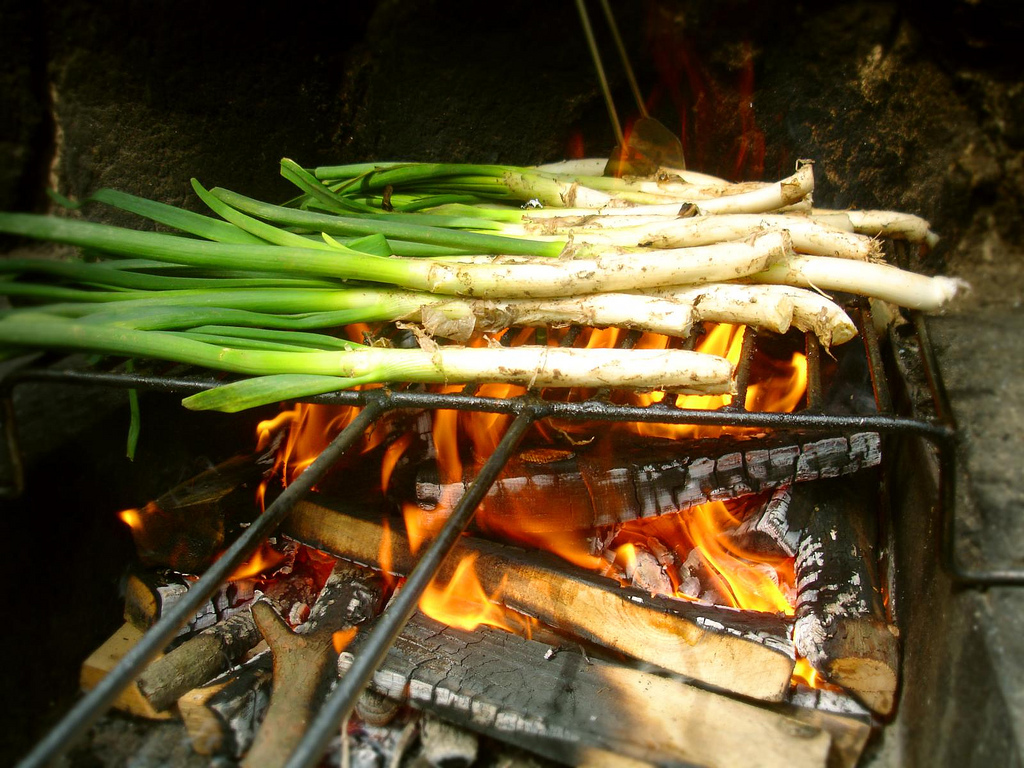Sunday afternoon and you’re invited to…. a calçotada? A castañada? What? Welcome to Catalonia, where agricultural bounty is celebrated with friends and family, and the whole neighborhood! Agriculturally-inspired festivities continue to thrive in Catalan culture, and especially in its capital city, Barcelona. From season to season, you’ll find yourself stumbling upon public plaças filled revelers sitting around tables and enjoying the local harvest. Here are a few gastronomic festivities observed by Catalan folk:
Calçotadas



 Anywhere from November to April, it’s more than likely you’ll encounter smell of grilled calçots while walking through the neighborhood. Just what are calçots, exactly? They’re a type of scallion, or green onion, unique to Catalonia! Rumor has it they were originally cultivated in the 20th century. In any case, the celebration of eating calçots, known as calçotadas in Catalan, are a staple celebration of the region. Typically, the scallion-like calçots are lined up on a grill and cooked over an open fire, served wrapped in newspaper, stripped from their charred skin and gratuitously dipped in unbelievably delicious romesco sauce specially made for the occasion! Romesco sauce is a beautiful shade of red, made with raw almonds, red peppers, pine nuts, red peppers, and bread. Be sure to ask for extra sauce before the event starts…everyone is always left wanting more! Finally, your calçots are served with red wine and bread. Oh, and don’t wear white: playing with charred çalcots can be tricky business when it comes to keeping clean.
Anywhere from November to April, it’s more than likely you’ll encounter smell of grilled calçots while walking through the neighborhood. Just what are calçots, exactly? They’re a type of scallion, or green onion, unique to Catalonia! Rumor has it they were originally cultivated in the 20th century. In any case, the celebration of eating calçots, known as calçotadas in Catalan, are a staple celebration of the region. Typically, the scallion-like calçots are lined up on a grill and cooked over an open fire, served wrapped in newspaper, stripped from their charred skin and gratuitously dipped in unbelievably delicious romesco sauce specially made for the occasion! Romesco sauce is a beautiful shade of red, made with raw almonds, red peppers, pine nuts, red peppers, and bread. Be sure to ask for extra sauce before the event starts…everyone is always left wanting more! Finally, your calçots are served with red wine and bread. Oh, and don’t wear white: playing with charred çalcots can be tricky business when it comes to keeping clean.
Castañadas

 A castañada, celebrated in both Galicia and Catalonia, traditionally takes place during All Saint’s Day, on November 1st. Castañas, or chestnuts, are seen in heaping piles all over markets in Catalonia and neighboring regions from mid-October to the end of December. While you can always get your chestnut-fix from your local Catalan street vendor, roasting chestnuts over a barrel-bound fire, you don’t want to miss your local castañada. Sweet wine, panelletes, and more chestnuts than you can imagine are usually the typical arrangement found at your castañada.
A castañada, celebrated in both Galicia and Catalonia, traditionally takes place during All Saint’s Day, on November 1st. Castañas, or chestnuts, are seen in heaping piles all over markets in Catalonia and neighboring regions from mid-October to the end of December. While you can always get your chestnut-fix from your local Catalan street vendor, roasting chestnuts over a barrel-bound fire, you don’t want to miss your local castañada. Sweet wine, panelletes, and more chestnuts than you can imagine are usually the typical arrangement found at your castañada.
Dotze Raïms

 Dotze Raïms, or twelve grapes in Catalan, is a tradition celebrated all over Spain and recently in other Spanish-speaking countries. Its origins are unknown, but it is said that the tradition started in 1895 after an over-abundance in grape production by vineyards. On Nochevieja—New Year’s Eve, in Spanish—people all over Spain gather around tables, each equipped with twelve grapes to be eaten with the twelve sounds of the bell tolling, to welcome the New Year. The goal is to put twelve grapes in your mouth in twelve seconds, for twelve months of good luck!
Dotze Raïms, or twelve grapes in Catalan, is a tradition celebrated all over Spain and recently in other Spanish-speaking countries. Its origins are unknown, but it is said that the tradition started in 1895 after an over-abundance in grape production by vineyards. On Nochevieja—New Year’s Eve, in Spanish—people all over Spain gather around tables, each equipped with twelve grapes to be eaten with the twelve sounds of the bell tolling, to welcome the New Year. The goal is to put twelve grapes in your mouth in twelve seconds, for twelve months of good luck!



